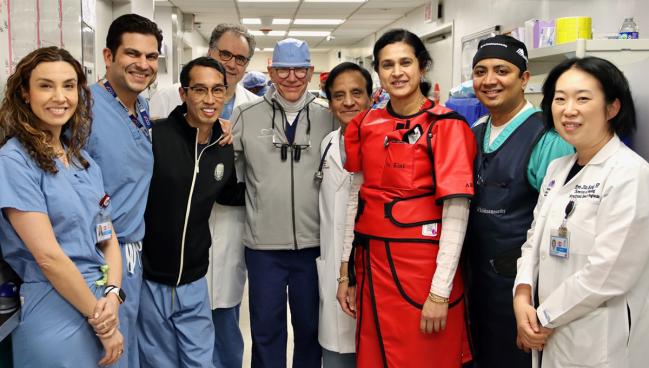Initial US Commercial TriClip Cases Offer Hope, but Reimbursement Still a Big Question
While they’re glad to have the option, operators wonder about the impact of payers on the rollout of the novel technology.

Photo Credit: Gilbert Tang
Northwell Health, in Manhasset, NY, was an enrolling site for the TRILUMINATE pivotal trial of TriClip (Abbott), and for Northwell cardiologist Bruce Rutkin, MD, the commercial availability of the device this spring provided a timely treatment solution that he soon found a need to apply in his practice.
Back in April, when the US Food and Drug Administration approved TriClip for patients with symptomatic severe tricuspid regurgitation (TR) based on the TRILUMINATE results, Rutkin had a patient experience acute decompensation while still being evaluated for a tricuspid intervention.
“We needed to expedite therapy and so we just did our usual routine, which was working with the heart failure team, imaging him, doing a transesophageal echo, and while we were open to either [repair or replacement], we felt that his anatomy was suitable for edge-to-edge repair,” Rutkin told TCTMD. This preprocedure process, which Rutkin calls “prehab,” is crucial to ensuring that patients chosen for tricuspid transcatheter edge-to-edge repair (T-TEER) are not in active heart failure or volume overload.
Their 72-year-old patient, himself a practicing physician, became the first commercial TriClip patient on Long Island.
“We bring the patients back for a 30-day echo, and so he came back and he’s doing well, he’s feeling better, and the TR reduction was exactly what we had achieved acutely in the cath lab,” Rutkin added.
Celebrating New Options
Since April, numerous cath labs have been marking the occasions of their first commercial T-TEER procedures by posting photos of their structural and imaging teams brandishing the telltale, oversized blue boxes on social media. As the commercial rollout continues, operators are gaining new insights and pondering still-looming questions.
1st commercial US #triclip case! proud to see this happen. Fantastic result in complex pathology! Made possible by outstanding teams at @AllinaHealth @MHIF_Heart @AbbottNews world class partners @HamidNadira @JoaoLCavalcante @bapat_savrtavr @kvoudris @MHIValveDoc + many others pic.twitter.com/Lz0d72ld7P
— Paul (@psorajja) April 5, 2024
While Rutkin and his team had experience with the device via the trial, others like Kashish Goel, MD (Vanderbilt University Medical Center, Nashville, TN), got to try it out only after the FDA’s regulatory green light.
Their first patient was considered for enrollment in a tricuspid replacement clinical trial at their center but was ultimately not a good candidate, so that initial TriClip device went straight to her.
“This patient was on home oxygen for interstitial lung disease and that’s why she was excluded from all the clinical trials,” Goel said. “That’s where having a commercial device [for] someone who is otherwise a good candidate is very helpful and . . . is a game changer, in my opinion, that will help a lot of patients.”
Goel attended a TriClip course to better understand the system and how to select appropriate cases, but going in he had substantial tricuspid experience, just not with this particular device. “So it was more about getting to know the system, which was very easy,” he added. “My personal goal is that if we are doing a TriClip, we need to reduce the TR as much as possible because those are the patients who feel the best afterward.”
While he and other operators had often used MitraClip (Abbott) off-label in tricuspid cases, the TriClip device improved the ability to navigate coaxially and deploy the clip appropriately, he said.
“We ended up doing three clips in the first case and we had a trivial TR at the end of the procedure. So, we actually had an excellent result,” Goel said. The patient was discharged 2 days later.
Learning the Ropes
With the approval of Evoque (Edwards Lifesciences), the first transcatheter tricuspid valve replacement (TTVR) device, earlier this year, operators now have two good transcatheter options for tricuspid management—sparking conversations as to which one might be best in any given patient.
Gilbert Tang, MD (Mount Sinai Health System, New York, NY), who was on the national screening committee for TRILUMINATE, said that question is paramount for operators.
“I think it depends on several factors with potential trade-offs,” he noted. “T-TEER is extremely safe, needs no anticoagulation, and [the] patient can go home next day but often at the expense of residual TR. TTVR usually eliminates TR but requires a CT scan to evaluate anatomic feasibility and carries risks of acute RV dysfunction, pacemaker implantation, and bleeding from anticoagulation plus unknown durability/valve thrombosis risk, based on the TRISCEND II trial.”
But Tang added that functionally, at least based on his group’s experience, TTVR patients report feeling “great.” T-TEER patients also feel great, but the treatment necessitates reducing TR to 2+ or better to confer benefit as shown in the TRILUMINATE trial. In certain complex anatomies, like RV lead at the center with leaflet tethered, or four- and five-leaflet valve morphology, it can be more challenging to reduce TR to 2+ or less with T-TEER, especially when baseline TR is massive or torrential.
Congratulations to Dr. Mark Ricciardi and the Endeavor Health Cardiovascular Institute team for performing the first commercial TriClip implant in the Midwest! This is groundbreaking for those suffering from tricuspid regurgitation and are unable to withstand surgery. #Abbott pic.twitter.com/JZOjbZt3sT
— Endeavor Health (@EndeavorHlth) May 1, 2024
“What we've gotten pretty good at with our imagers,” Rutkin said, “is really being able to evaluate the anatomy by TEE and predict, okay, this is a patient that we are very confident based on the anatomy that we're going to be able to achieve a two-grade reduction, or we're going to get this patient to mild or less TR and so we're going to go with the clip.”
The approval of TriClip seems to have brought an increase in awareness among referring physicians, and in some cases among patients themselves, he added.
“What we are seeing now is the early stages of general movement where we’re now getting patients who may be eligible referred to us,” Rutkin said. “You have patients coming in [saying]: ‘I have a leaky tricuspid valve and I was previously told that there was nothing that could be done or it required surgery and I didn't want surgery and now there's an option.’ It’s not like we’re doing five cases a week at this point, [but] we're seeing a large bolus of patients that are being referred in to be evaluated that previously we're not being referred to our valve center.”
Booming Referrals
Brandon M. Jones, MD (Providence Valve Center, Portland, OR), who enrolled patients in TRILUMINATE and recently did his first commercial case, said one of the biggest things he took away from the trial experience was how many patients are out there in need of a treatment option.
“Most tricuspid regurgitation is in the context of other types of problems and isolated tricuspid valve surgery is always extremely high risk and has had relatively poor outcomes. So, we sort of lost track of these people. People stopped referring them to valve teams and heart surgery teams, and there was no interventional cardiology options for them,” he told TCTMD.
Jones said there are an estimated 1.6 million people in the US with severe tricuspid valve disease and fewer than 1,500 tricuspid valve surgeries performed each year. “They sort of just suffered silently in heart failure clinics and were dubbed heart failure with preserved ejection fraction in a lot of cases. When we opened the [TRILUMINATE] trial, we started getting these patients from all over the place,” he added.
For their first commercial procedure, Jones and his team chose Pat, a woman in her 80s whose friend had been a TRILUMINATE patient.
“The woman that did it as part of the trial didn't know what she was risking or what she stood to gain from doing it because it was still kind of unknown, but she was pretty desperate and she was symptomatic. Her friend Pat maybe never would have gotten the procedure had it not been for people like [her friend] who altruistically engaged in this research trial,” he noted.
Pat was one of about a dozen patients who Jones and his team had been in the process of screening for eligibility criteria as TRILUMINATE was coming to a close.
“So, we had a pretty big group that were eagerly awaiting commercial approval,” he said. As they transitioned to being able to offer the procedure outside of the trial, they continued to adhere to patient-specific anatomical considerations learned from the TRILUMINATE experience.
Like her friend before her, Pat did well and continues to have a solid reduction in TR as well as significant gains in quality of life (QoL), Jones said. A second commercial case also has been done successfully by his team.
#BIDMC #StructuralHeart Program recently performed the first #TriClip #TEER implant in New England. An innovative solution for patients with #TricuspidRegurgitation who are not eligible for open-heart surgery. pic.twitter.com/GbMBN8Cv8T
— BIDMC CVI (@BidmcCvi) May 15, 2024
Goel said he fully expects to see a big bump in patient referrals in the coming months given that mortality with isolated tricuspid valve replacement in the US is about 5%-6% based on data from the Society of Thoracic Surgeons.
“With [TriClip] you have a therapy which has minimal mortality,” he said. “There is no comparison.”
More Questions
With that bump in referrals, however, comes the burden of explaining to patients what they can expect from this new therapeutic option—and what they can’t, Rutkin noted.
“One of the most common questions with structural intervention is, ‘Am I coming off my meds? Can I come off my diuretics?’” he said, adding that the answer is not necessarily the one they want to hear: medications will still be needed. “The way we frame it to patients is there are multiple different things that we have in the toolbox and everything is important. So, it's not just one thing. Getting a TriClip or getting a TTVR is not like a magic bullet that's going to completely cure the disease. Yes, it may reduce the degree of tricuspid regurgitation, but it's not going to instantaneously reverse the sequelae that built up over years.”
In TRILUMINATE, TriClip patients had a more favorable primary composite outcome (all-cause death or tricuspid valve surgery, hospitalization for heart failure, and improvement in QoL) after 1 year than patients treated with medical therapy alone. The benefit, however, was largely driven by improvements in quality of life.
Rutkin believes the combination of being optimized on medications and receiving the TriClip is the key to patients seeing dramatic 20-point or greater improvements in QoL, one that is important to maintain as the procedure transitions into the real world.
“We tell patients that . . . we think based on the data that we're going to make you feel better. We think it's going to improve your quality of life. Maybe it'll improve your functional capacity, and maybe over time we might even see that it reduced your risk of long-term mortality because it mitigated your risk of developing right-sided heart failure. We don't know for a fact, but those are the things we'll talk to patients about,” he added.
Notably, mortality reductions have not been demonstrated in the randomized trials.
“The compelling thing about the procedure is the extremely low risk of taking somebody and making them feel worse,” Jones said. “They don't want to go back to feeling like they're 50 again. Both of our [commercial] patients were in their 80s and they know they don't have a lot of years left to live, but [offering] a 20%, 30% improvement in their quality of life sometimes is really meaningful.”
Financial and Other Considerations
One of the major questions now is how payers will ultimately view the value of the procedure given that the primary benefits, shown thus far at least, are related to QoL. In TRILUMINATE, T-TEER did not reduce heart failure hospitalizations or improve survival on top of optimal medical therapy.
“With replacement, there are still a lot of exclusions based on anatomy . . . probably a 30% acceptance rate at most. So in that regard, TriClip is probably more feasible. But TriClip has its disadvantage in that it may not reduce the TR as much as TTVR,” Goel said. The commercial experience just getting started in the US will add needed data to understand which patients fare best with TriClip and it will expand on the clinical benefits in a way that may clarify the procedure’s role in the TR population at large beyond what could be shown in TRILUMINATE, he added.
With no national coverage determination (NCD) for either TriClip or Evoque from the Centers for Medicare & Medicaid Services, however, the next year may try the patience of physicians and patients alike, Jones said.
“The guidance that we had been given from industry partners is that patients with standard Medicare will be covered, but patients with Medicare Advantage or private insurers are likely to get denied even in a prior authorization appeal type process until an NCD comes through,” he added. His first two commercial TriClip patients both had standard Medicare and the coverage was approved.
🥇 We have successfully performed the region's first #TriClip procedure, offering new hope for patients suffering from #TricuspidValveRegurgitation 🎉
— Loma Linda U. Health (@LLUHealth) June 18, 2024
Learn more ⤵️ #MedTwitterhttps://t.co/D0j9TsDrKl
Still, in order for operators to get their hands on the new device they will need to meet and plan with hospital administrators to decide the rate at which they will roll out a TriClip program, which in many cases will require assurances of reimbursement that can only happen by waiting to see what transpires with the initial commercial cases.
Jones said the frustration of many patients is evident because they know that it was FDA approved months ago and “I think most of the patients assumed that that meant we would schedule their procedures next week.”
The reimbursement uncertainties are a widespread problem at the moment, Rutkin agreed.
“We are definitely right now in this kind of ‘gray zone’ until all that stuff comes through, which is usually within the first year. [Hopefully] then we will start to see some of those issues going away,” he added.
Keeping an Eye on Safety
In the first few months of use, the safety of TriClip has not been questioned, and back in February, the FDA’s advisory panel voted 14-0 on the question of safety. For the MitraClip, with its similar design, reports of malfunctions, injuries, and deaths related to the device or the procedure have continued to accrue in the years since FDA approval.
An investigation last month by KFF Health News found that as of March 2024, the FDA had received more than 17,000 reports that documented over 22,000 adverse events involving mitral valve repair devices since their approval more than a decade earlier.
A 2023 article published in JACC: Cardiovascular Interventions shed light on this issue when it reviewed more than 5,200 reports of adverse events in the Manufacturer and User Facility Device Experience (MAUDE) database dating back to January 1, 2020, that were specific to MitraClip. Single-leaflet device attachment (SLDA), device opening while locked or failure to establish final arm angle, and gripper-related issues were the most common adverse events reported.
In particular, the study showed locking failure appeared to be increasing in incidence through the first half of 2022—Abbott addressed this concern in a Urgent Medical Device Correction letter that September. While a malfunction report may be issued for these events, they are often considered benign because the clip can be removed from the patient without harm.
Whether TriClip will have similar issues is as yet unknown.
A look at MAUDE for TriClip shows that between April 2024 and the end of July 2024 there have been 20 reports of injury and nine reports of malfunction with the TriClip device in the US. Some of the cases involve SLDA, which was seen in a dozen patients in the TRILUMINATE trial within 30 days. The MAUDE reports show that many of the devices for which a report was issued were considered successfully implanted and the clips themselves remain in the patient, so are unavailable for further investigation by the manufacturer.
The denominator here is a mystery, however; an Abbott spokesperson told TCTMD it does not disclose this information.
When the FDA approved TriClip, it mandated two postapproval studies. One will follow the premarket patients through 5 years. The other will focus on the real-world experience with 5-year follow-up that will include all consecutive patients treated within the first 2 years after approval or a total of 5,000 consecutively treated patients, whichever is greater. At least 50% of those patients must be from new sites that did not participate in TRILUMINATE, and a minimum of 100 patients each must be included from prespecified underrepresented racial and ethnic groups. Follow-up data will include all-cause mortality, stroke, tricuspid valve reintervention, and hospitalization.
L.A. McKeown is a Senior Medical Journalist for TCTMD, the Section Editor of CV Team Forum, and Senior Medical…
Read Full BioDisclosures
- Rutkin reports consulting for Abbott, Medtronic, and Edwards Lifesciences.
- Goel reports intuitional research funding from Medtronic and serving as a proctor/consultant for Edwards Lifesciences and Abbott.
- Jones reports serving as a proctor for Gore and a proctor/speaker for Abbott Vascular.
- Tang has received speaking honoraria and served as a physician proctor, consultant, advisory board member, TAVI publications committee member, APOLLO trial screening committee member, and IMPACT MR steering committee member for Medtronic; has received speaking honoraria and served as a physician proctor, consultant, advisory board member and TRILUMINATE trial anatomic eligibility and publications committee member for Abbott Structural Heart; has served as an advisory board member for Boston Scientific and JenaValve and a consultant for NeoChord, Shockwave Medical, Peija Medical and Shenqi Medical Technology; and has received speaking honoraria from Siemens Healthineers.





Comments